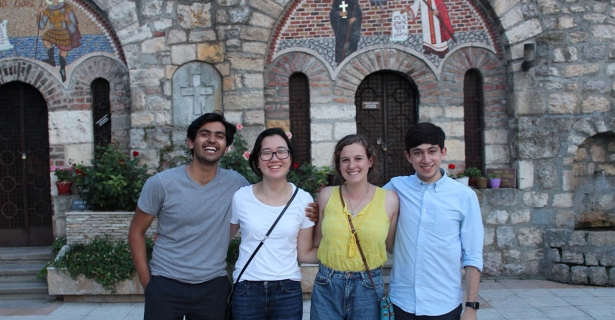The title comes from Srdja Popovic’s book, Blueprint for a Revolution
As part of the IGL’s Oslo Scholars program, this summer I am interning with Srdja Popovic and his organization, the Centre for Applied Nonviolent Action Strategies (CANVAS). Since reading Nelson Mandela’s Long Walk to Freedom, I always had the idea that it was an amalgamation of both non-violent and violent protest that led to a positive outcome for any given society. In retrospect, the naivety of this assumption amuses me. Both through empirical readings of innumerable non-violent protests to my conversations with Srdja and the other trainers, I have come to understand non-violent “people power” and its ability to be more effective than any violent protest. In fact, it is not morality but the higher probability of success from non-violent revolutions that drives CANVAS.
In my time here, I have had the delight of working with trainees and activists from Zimbabwe, Nicaragua, Cambodia, Vietnam, Togo and others. While observing Skype conversations between Srdja and these activists, I am constantly astonished by the level of motivation and energy I witness. While acknowledging that each non-violent movement needs to be contextually tempered to mobilize people, CANVAS provides a toolkit, drawing from their own experiences with Serbian President Slobodan Milosevic in the early 2000s, which serves as a template for other protests across the globe. Ranging from an organization in the United States that is seeking help to galvanize voters, to working with an Oscar-winning director who is working on creating a documentary to tackle climate change, I have worked on a range of problems which have broadened my idea and understanding of the range of ways to enable positive change.
Additionally, our work also entails compiling weekly and bi-weekly news for general readers and activists around the world. The concentration of this has been Zimbabwe, United States and the South-East Asian countries. Being the only non-US citizen among the interns, I have had the satisfaction of working on the aforementioned report. I am also responsible for creating a country analysis for my home country, India, and I hope to have a detailed document by the end of my time here. In conjunction with my daily work, I experience the pleasure of being challenged and amazed by the quality of interns around me. From the conversations during lunch to our movie nights on Saturday, I have been lucky to work with people who are deeply motivated and enthused by the issue of human rights and the former’s universality across borders.
One of my takeaways from the past month is the acceptance of the idea that regardless of circumstances or one’s position in society, it is anyone and generally “ordinary” men and women which can have the greatest effect in catalyzing change. Change is not limited to toppling dictatorships and instilling democracy thereafter, but encompasses a wide variety of efforts which need not capture the national headlines. I hope that by the end of my stay here, I would be more educated in helping communities, groups and individuals in strategizing and creating effective positive improvements in the societies around them. There is no limit to the violence, poverty and abhorrent racism and communalism present across the globe today, and “people power” is essential to tackling the aforementioned problems. Quoting the father of non-violent movements Gene Sharp, “The degree of liberty or tyranny in any government is in large degree a reflection of the relative determination of the subjects to be free and their willingness and ability to resist efforts to enslave them.” Taking this as gospel, I sincerely hope that with growing awareness and increasing information, we do not turn apathetic to the misery of those around us, but use our power and influence to positively shape our surroundings.
In addition to my internship, it has been an interesting and challenging first month in Belgrade. I have done my fair share of travelling around the city and have visited both the Ethnographic Museum and the National Museum of Yugoslav History. Belgrade is an interesting mix of the old and the new. New Belgrade was formed after the communist era, and Old Belgrade reeks of wars and destruction that were continuously witnessed in the twentieth century. I have also visited Zemun - an expanse on the banks of the river Sava, churches and monuments that survived communism, and Novi Sad, a city near the Hungarian border.

